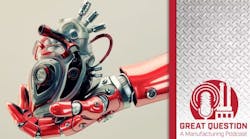Podcast: 4 Ways 3D Printing and Robotics are Reinventing the Healthcare Industry
The medical profession, like many other industries, is experiencing a technological renaissance. Advancements that were once only contained in the works of science fiction are steadily appearing in doctors’ offices, hospitals, and operating rooms across the world. Robotics and 3D printing are leading the charge, helping to treat and diagnose patients with various ailments. In this episode of Great Question: A Manufacturing Podcast, I explore the latest technological advancements that are reshaping healthcare as we know it.
Below is an excerpt from the podcast:
First up on our list is an extraordinary creation from the University of Waterloo, where researchers have pioneered a wound dressing tailored specifically for burn victims. Led by Dr. Boxin Zhao and his team, this 3D-printed dressing, crafted from advanced polymers, not only expedites the healing process but also offers much-needed pain relief. Imagine bandages that conform seamlessly to every contour, thanks to personalized 3D scanning, providing unparalleled comfort and efficacy.
Using 3D scanning, the researchers scan patients' faces and body parts to get customized data and then 3D-print a customized bandage shape according to each individual's specific needs. Doing so helps to ensure that the bandages adhere well to body parts such as the nose and fingers.
The bandage, made of intelligent materials known as hydrogels—developed by Dr. Zhao's team—creates a reusable bandage that easily adheres to the damaged skin and is easy to take off.
The advanced polymers the material is made out of include a biopolymer derived from seaweed that has thermal properties and cellulose nanocrystals. The thermal property lets the dressing warm on the skin and then gently lowers to room temperature, slightly shrinking over the area, making it easier and less painful to remove. The material can also expand when put into a chilled environment, such as a fridge.
About the Podcast
Great Question: A Manufacturing Podcast offers news and information for the people who make, store and move things and those who manage and maintain the facilities where that work gets done. Manufacturers from chemical producers to automakers to machine shops can listen for critical insights into the technologies, economic conditions and best practices that can influence how to best run facilities to reach operational excellence.
Listen to another episode and subscribe on your favorite podcast app
Laura Davis | Editor-in-Chief
Laura Davis is the editor-in-chief of New Equipment Digest (NED), a brand part of the Manufacturing Group at Endeavor Business Media. NED covers all products, equipment, solutions, and technology related to the broad scope of manufacturing, from mops and buckets to robots and automation. Laura has been a manufacturing product writer for seven years, knowledgeable about the ins and outs of the industry along with what readers are looking for when wanting to learn about the latest products on the market.
About the Author
Laura Davis
Editor-in-Chief, New Equipment Digest
Laura Davis is the editor in chief of New Equipment Digest (NED), a brand part of the Manufacturing Group at EndeavorB2B. NED covers all products, equipment, solutions, and technology related to the broad scope of manufacturing, from mops and buckets to robots and automation. Laura has been a manufacturing product writer for eight years, knowledgeable about the ins and outs of the industry, along with what readers are looking for when wanting to learn about the latest products on the market.
